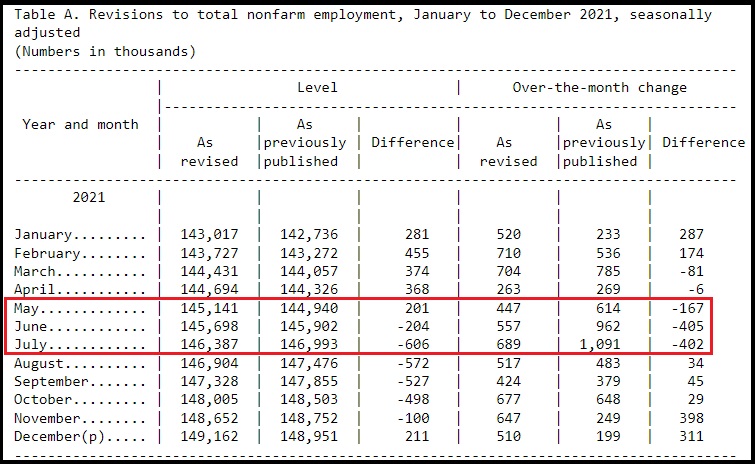
There really isn’t an adequate way to encapsulate what the Bureau of Labor and Statistics has done with their reported January jobs result [Main Data Here]. If you want a deep weeds review of the actuarial scheme deployed READ THIS ARTICLE.
In my lifetime of reviewing data and analytics, I have never reviewed a level of statistical manipulation that even comes close to this. Well, at least not since the 1980’s junk bond valuations used for corporate restructuring and asset removal. What the BLS produced today will likely go down in the annals of actuarial history as one of the most comprehensively fraudulent manipulations of labor and statistics in history.

In order to get to a point of being able to claim 467,000 job gains last month, the BLS needed to revise four years’ worth of claimed jobs and population data. By subtracting over a million prior jobs from 2021, essentially wiping out the COVID pandemic monthly impact, and by changing the workforce population over the same number of years, the BLS was able to recalculate the current number of people in the workforce and claim 467,000 jobs were recently created.
Again, to unpack this effort would require a week of intensive education on statistics. {Summary Here}
To avoid that complexity, just think of the big picture this way:
In order to claim a nonexistent gain today, you have to change what took place before.
Ex. Your home is worth $1.4 million as of this morning. Your home is worth $400,000 more today alone. Why? Because your appreciation was stopped for the past year, and you are now comparing January 2022 to December 2020 when your home was worth $1 million. You need to pretend the $33,000 your home was gaining in value each month never existed. Instead, your home went from $1 million to 1.4 million in one day, today.
This is, essentially, the methodologic mindset behind the statistical manipulation.
Additionally, again using this actuary example, to justify your current home valuation to a quizzical audience (a potential buyer), the appraiser (BLS) would have to change every previously appraised value of the entire neighborhood – for every comparable that took place in the prior year. This is akin to changing the population in the workforce statistics.
The problem becomes that once you set this numerical foundation (the number of people working), all subsequent job reports will have to reflect a new position against a higher base. Without expanded economic activity to support it, future job gains will be lowered because they are going up against a higher baseline, because the entire population of workers has been changed.
We also know that U.S. economic activity is not expanding.
The value of this January BLS report is essentially nil.
All of that said, there is still a macro BLS data point that deserves emphasis. Remember the timeline CTH shared previously about the economy and employment changing in May and June of 2021? That date corresponded with the 2021 massive jump in inflation; yet, none of the data being assembled seemed to show it?
Look at the specific timeframe BLS used to drop the majority of their 2021 employment numbers:

It is not coincidental the BLS used the last half of the year to remove 2.5 million claimed workers (subsequently the jobs they held). The COVID excuse, Delta and Omicron waves, are the cover story for this revision. The BLS now position the workforce as 149.16 million in December – an increase of roughly 6 million workers from the revised 143.0 million in January.
As one person put it, “there’s cooking numbers, and then there’s cast iron skillet deep frying numbers.”
Yup, the BLS has compiled a burnt offering – upon the altar of sacrificing their credibility.
